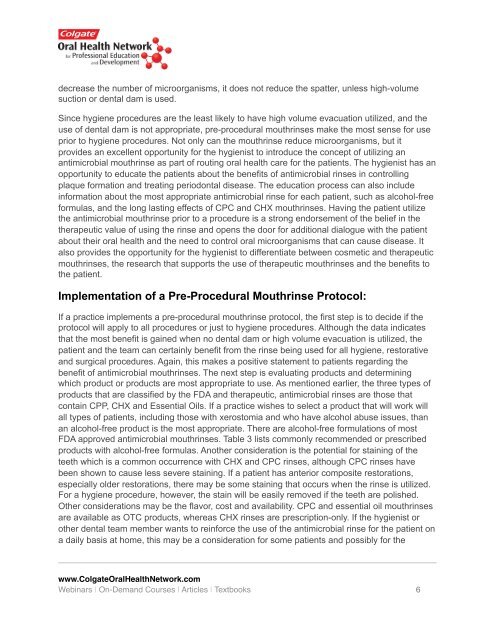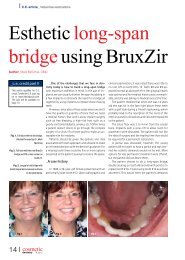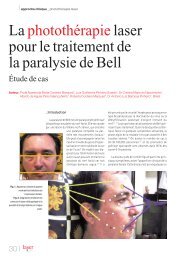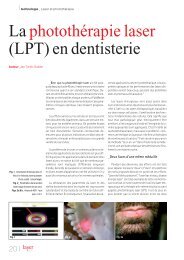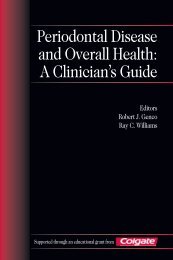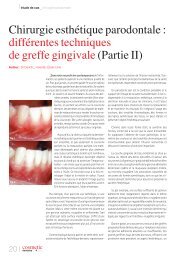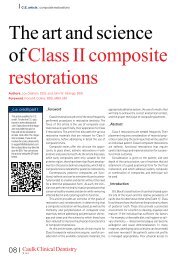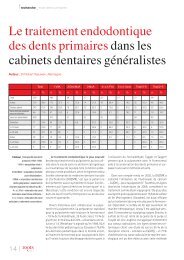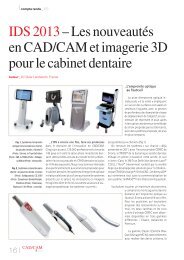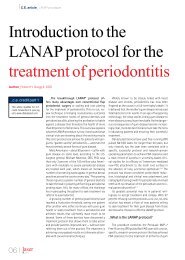The Role of Antimicrobial Mouth Rinses in Infection Prevention
The Role of Antimicrobial Mouth Rinses in Infection Prevention
The Role of Antimicrobial Mouth Rinses in Infection Prevention
Create successful ePaper yourself
Turn your PDF publications into a flip-book with our unique Google optimized e-Paper software.
decrease the number <strong>of</strong> microorganisms, it does not reduce the spatter, unless high-volume<br />
suction or dental dam is used.<br />
S<strong>in</strong>ce hygiene procedures are the least likely to have high volume evacuation utilized, and the<br />
use <strong>of</strong> dental dam is not appropriate, pre-procedural mouthr<strong>in</strong>ses make the most sense for use<br />
prior to hygiene procedures. Not only can the mouthr<strong>in</strong>se reduce microorganisms, but it<br />
provides an excellent opportunity for the hygienist to <strong>in</strong>troduce the concept <strong>of</strong> utiliz<strong>in</strong>g an<br />
antimicrobial mouthr<strong>in</strong>se as part <strong>of</strong> rout<strong>in</strong>g oral health care for the patients. <strong>The</strong> hygienist has an<br />
opportunity to educate the patients about the benefits <strong>of</strong> antimicrobial r<strong>in</strong>ses <strong>in</strong> controll<strong>in</strong>g<br />
plaque formation and treat<strong>in</strong>g periodontal disease. <strong>The</strong> education process can also <strong>in</strong>clude<br />
<strong>in</strong>formation about the most appropriate antimicrobial r<strong>in</strong>se for each patient, such as alcohol-free<br />
formulas, and the long last<strong>in</strong>g effects <strong>of</strong> CPC and CHX mouthr<strong>in</strong>ses. Hav<strong>in</strong>g the patient utilize<br />
the antimicrobial mouthr<strong>in</strong>se prior to a procedure is a strong endorsement <strong>of</strong> the belief <strong>in</strong> the<br />
therapeutic value <strong>of</strong> us<strong>in</strong>g the r<strong>in</strong>se and opens the door for additional dialogue with the patient<br />
about their oral health and the need to control oral microorganisms that can cause disease. It<br />
also provides the opportunity for the hygienist to differentiate between cosmetic and therapeutic<br />
mouthr<strong>in</strong>ses, the research that supports the use <strong>of</strong> therapeutic mouthr<strong>in</strong>ses and the benefits to<br />
the patient.<br />
Implementation <strong>of</strong> a Pre-Procedural <strong>Mouth</strong>r<strong>in</strong>se Protocol:<br />
If a practice implements a pre-procedural mouthr<strong>in</strong>se protocol, the first step is to decide if the<br />
protocol will apply to all procedures or just to hygiene procedures. Although the data <strong>in</strong>dicates<br />
that the most benefit is ga<strong>in</strong>ed when no dental dam or high volume evacuation is utilized, the<br />
patient and the team can certa<strong>in</strong>ly benefit from the r<strong>in</strong>se be<strong>in</strong>g used for all hygiene, restorative<br />
and surgical procedures. Aga<strong>in</strong>, this makes a positive statement to patients regard<strong>in</strong>g the<br />
benefit <strong>of</strong> antimicrobial mouthr<strong>in</strong>ses. <strong>The</strong> next step is evaluat<strong>in</strong>g products and determ<strong>in</strong><strong>in</strong>g<br />
which product or products are most appropriate to use. As mentioned earlier, the three types <strong>of</strong><br />
products that are classified by the FDA and therapeutic, antimicrobial r<strong>in</strong>ses are those that<br />
conta<strong>in</strong> CPP, CHX and Essential Oils. If a practice wishes to select a product that will work will<br />
all types <strong>of</strong> patients, <strong>in</strong>clud<strong>in</strong>g those with xerostomia and who have alcohol abuse issues, than<br />
an alcohol-free product is the most appropriate. <strong>The</strong>re are alcohol-free formulations <strong>of</strong> most<br />
FDA approved antimicrobial mouthr<strong>in</strong>ses. Table 3 lists commonly recommended or prescribed<br />
products with alcohol-free formulas. Another consideration is the potential for sta<strong>in</strong><strong>in</strong>g <strong>of</strong> the<br />
teeth which is a common occurrence with CHX and CPC r<strong>in</strong>ses, although CPC r<strong>in</strong>ses have<br />
been shown to cause less severe sta<strong>in</strong><strong>in</strong>g. If a patient has anterior composite restorations,<br />
especially older restorations, there may be some sta<strong>in</strong><strong>in</strong>g that occurs when the r<strong>in</strong>se is utilized.<br />
For a hygiene procedure, however, the sta<strong>in</strong> will be easily removed if the teeth are polished.<br />
Other considerations may be the flavor, cost and availability. CPC and essential oil mouthr<strong>in</strong>ses<br />
are available as OTC products, whereas CHX r<strong>in</strong>ses are prescription-only. If the hygienist or<br />
other dental team member wants to re<strong>in</strong>force the use <strong>of</strong> the antimicrobial r<strong>in</strong>se for the patient on<br />
a daily basis at home, this may be a consideration for some patients and possibly for the<br />
www.ColgateOralHealthNetwork.com<br />
Web<strong>in</strong>ars | On-Demand Courses | Articles | Textbooks 6


